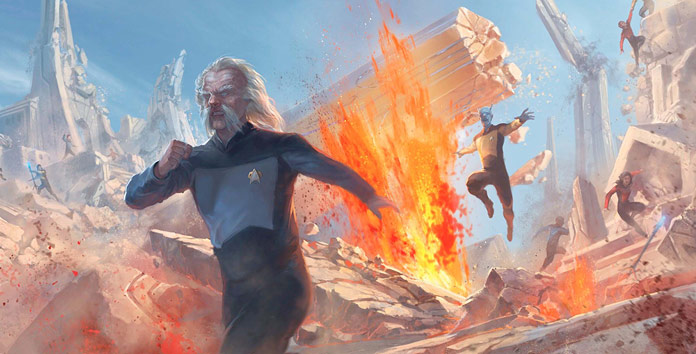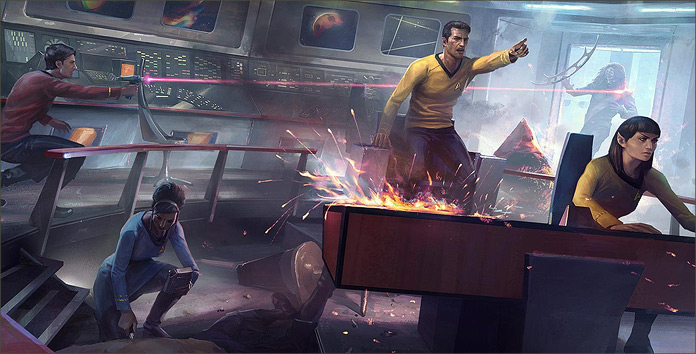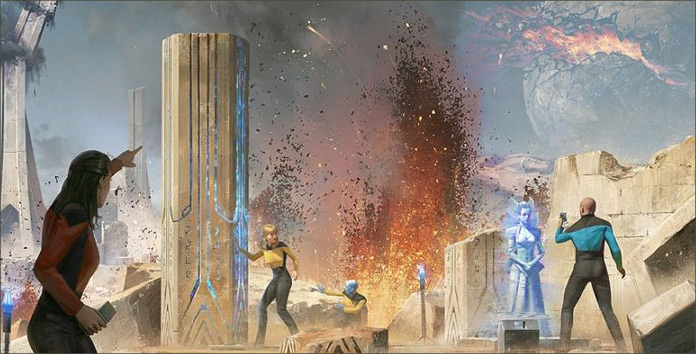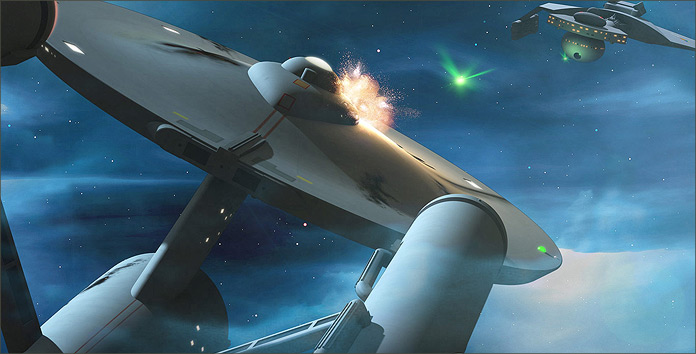Popular culture has spawned few fan communities as creative and passionate as Star Trek fandom. We attended conventions, fashioned our own costumes and wrote our own fan fiction long before such pursuits gained any sort of recognition among the larger culture.
For many of us, it wasn’t enough to watch Star Trek on television or at the movie theater. Instead, we longed to participate. We wanted to take part in our own adventures, to carve out our own place in Starfleet.
The catastrophic power failure took the turbolift completely offline, but the crew could still navigate the small science outpost by manually climbing up and down the empty turboshaft.
Suddenly, a plasma fire erupted at a junction point near the turboshaft ladder, leaving the route impassible and forcing the crew to find a new way of getting around the outpost. Jeffries tubes seemed like the obvious choice, but the executive officer never liked taking the easy way out.
“Let’s find the nearest airlock,” the executive officer said. “We’re going for a spacewalk.”
Enter the tabletop role-playing game, an interactive medium that allows a group of friends to get together and tell their own stories set in the final frontier (and maybe eat some snacks and goof off a little too).

The scene described briefly at the start of this column played out two weekends ago, when my gaming group and I played the latest scenario handed out as part of the Star Trek Adventures playtest. The text of the adventure included a couple alternatives that players might consider when faced with the challenge of navigating the outpost without turbolifts.
A spacewalk was not included on the menu, though. And that’s part of the beauty of tabletop role-playing games. Your imagination – along with what the gamemaster is willing to allow – is the only limitation. If you can dream it, you can do it, even if it’s not explicitly stated in the rules or the adventure module.
The Star Trek license has passed through the hands of some classic RPG publishers such as FASA, Last Unicorn Games and Decipher, but it’s now been over a decade since the last officially licensed game saw print. The license has stagnated while other big-time intellectual properties (Dungeons & Dragons, Star Wars and Firefly to name a few) have enjoyed a surge of enthusiasm in recent years for tabletop gaming.

But that changed last year when game publisher Modiphius Entertainment announced Star Trek Adventures, a new RPG slated for an official release later this year. We’re now in the middle of a public playtest of the game, and many of its core mechanics have begun to take shape.
The playtest allows fans to try out the game and help the designers hone the rules for optimal clarity and playability. The most recent rules update spans about 60 pages, and a separate document contains another 30 pages of rules on starship operations and ship-to-ship combat.
The rules don’t cover character generation guidelines yet, but they include 20 pre-generated characters from which players may choose. These pre-gens represent a range of Star Trek species such as human, Trill, Vulcan, Andorian, Bajoran, Denobulan, Betazoid and Tellarite.
Modiphius has crafted a “living playtest,” in which each player can retain his or her character from one adventure to another, forming an overarching story arc. The meta-story takes place in the Shackleton Expanse, a largely unexplored region of space jointly administered by Starfleet and the Klingon Empire.

Against this backdrop, players can choose to serve aboard one of three Next Generation-era vessels: The Galaxy-Class USS Venture, the Intrepid-Class USS Bellerophon and the Akira-Class USS Thunderchild. A fourth option, the Constitution-Class USS Lexington, gives gaming groups an opportunity to play in the classic Star Trek era.
I chose the USS Venture for my gaming group, owing to its well-rounded mission parameters and the fact that the Galaxy-Class is my all-time favorite starship design. The first adventure scenario written for the Venture, titled “Dying Star,” doesn’t actually spend much time on the ship though. Instead, the player characters quickly transport over to a small research outpost studying a mysterious star that appears to be losing its energy for no discernible reason.
The science outpost soon suffers a catastrophic power outage, plunging the Starfleet crew into a crisis they’ll have to solve without the help of much of their advanced technology. The adventure includes a variety of classic Trek ingredients, including an Orion freighter captain, a couple Naussican body guards and a sci-fi mystery.
The adventure is short and likely designed to be completed in a single session, which my group managed with time to spare.

The adventure captures the feel of an episode of The Next Generation, though the text doesn’t always do a great job of explaining to the gamemaster how all the components of the story should fit together, leaving much to the discretion of the gamemaster. That’s fine with me, though newer gamemasters may find that a bit daunting.
Star Trek Adventures utilizes the 2d20 system, the in-house engine Modiphius has used for several of its games. The basic mechanic requires players to roll a pair of 20-sided dice to determine the outcome of character actions. Each dice that rolls below a target number scores a success.
The game also relies heavily on mechanics called “Momentum” and “Threat” to heighten the dynamism of the story. Any time players achieve more successes than necessary, they receive Momentum that can be spent to unlock various bonuses and advantages. Likewise, gamemasters can bank a reservoir of Threat points they can use to create new obstacles the players must overcome.
The mechanic creates an economy of resources players and gamemasters use to tug the story in exciting new directions on the fly. In practice, it requires some getting used to as the rules governing the various uses of Momentum and Threat take some time to process. But once you’ve mastered the learning curve, you can use Momentum and Threat to mimic the dramatic twists and turns of an episode of Star Trek.

That’s largely how the spacewalk scenario described earlier came about. The players in my game had been climbing the turboshaft to get from one deck of the outpost to the next, so I, as the gamemaster, dipped into my Threat pool to create the plasma fire as a new challenge for the players to solve.
Rather than trying to put out the fire or entering the Jefferies tubes (two solutions recommended in the adventure document), one of the players suggested a spacewalk as a means of traveling two decks up. The player decided to use some Momentum points to improve the odds that the extra-vehicular activity would go as planned.
Ultimately, the scene played out like this:
The executive officer and the ensign, clad in environmental suits and magnetic boots, checked their equipment one last time before opening the airlock door. The hatch slid open, revealing the breathtaking vista of the Shackleton Expanse. The officers needed to reach the science labs two decks up to find out why the outpost was losing power. If they didn’t get there before life support failed, the crew would have to abandon the station.
“This might be a bad time to mention this, but I nearly failed my zero-g training at the Academy,” the ensign said, trying to keep his voice from quivering.
“It’s alright,” the executive officer said, taking the ensign by the arm. “We can do this.”
If you’ve ever imagined what it would be like to play the hero in an epic adventure – or if you’ve ever fantasized about taking the center seat on the bridge of the Enterprise – I can’t think of a better hobby to try than tabletop RPGs… and, just like the human adventure, this game is just beginning.
